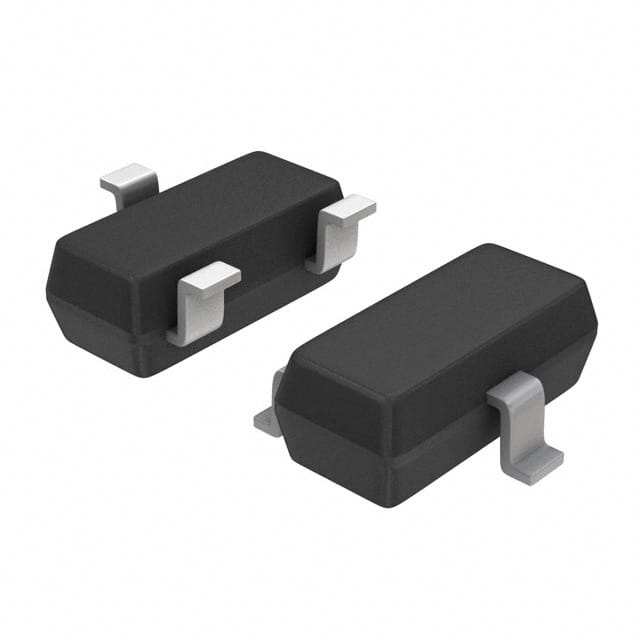BAS70LT1G
Product Overview
- Category: Diode
- Use: Rectification and signal processing
- Characteristics: High-speed switching, low leakage current
- Package: SOT-23
- Essence: Small Signal Schottky Diode
- Packaging/Quantity: Tape & Reel (3000 units per reel)
Specifications
- Forward Voltage Drop: 0.32V
- Reverse Voltage: 70V
- Forward Continuous Current: 70mA
- Reverse Recovery Time: 4ns
Detailed Pin Configuration
The BAS70LT1G is a three-pin device with the following pin configuration: 1. Anode 2. Cathode 3. No Connection
Functional Features
- High-speed switching for fast response times
- Low forward voltage drop for efficient power conversion
- Low reverse leakage current for improved performance
Advantages and Disadvantages
Advantages
- Fast switching speed
- Low forward voltage drop
- Small package size
Disadvantages
- Limited reverse voltage capability
- Relatively low forward continuous current rating
Working Principles
The BAS70LT1G operates based on the principles of Schottky diode behavior, utilizing a metal-semiconductor junction to enable high-speed switching and low forward voltage drop.
Detailed Application Field Plans
The BAS70LT1G is commonly used in applications such as: - Signal rectification in communication systems - Voltage clamping in protection circuits - Signal demodulation in audio and video equipment
Detailed and Complete Alternative Models
Some alternative models to the BAS70LT1G include: - BAT54C: Similar characteristics and package, suitable for similar applications - BAV99: Dual diode configuration, suitable for more complex circuit designs - 1N5819: Higher reverse voltage capability, suitable for different voltage requirements
This comprehensive entry provides an in-depth understanding of the BAS70LT1G, covering its specifications, functional features, advantages, disadvantages, working principles, application field plans, and alternative models, making it a valuable resource for engineers and enthusiasts alike.
Senaraikan 10 soalan dan jawapan biasa yang berkaitan dengan aplikasi BAS70LT1G dalam penyelesaian teknikal
What is BAS70LT1G?
- BAS70LT1G is a dual common cathode switching diode with a maximum continuous forward current of 200 mA and a reverse voltage of 70 V.
What are the typical applications of BAS70LT1G?
- BAS70LT1G is commonly used in high-speed switching applications, such as in signal and data lines, small-signal switching, and protection circuits.
What is the maximum forward voltage drop of BAS70LT1G?
- The maximum forward voltage drop of BAS70LT1G is typically around 0.715 V at a forward current of 100 mA.
What is the reverse recovery time of BAS70LT1G?
- The reverse recovery time of BAS70LT1G is typically around 4 ns, making it suitable for high-speed switching applications.
Can BAS70LT1G be used in rectifier circuits?
- Yes, BAS70LT1G can be used in low-power rectifier circuits due to its fast switching characteristics and low forward voltage drop.
What is the operating temperature range of BAS70LT1G?
- BAS70LT1G is designed to operate within a temperature range of -65°C to 150°C, making it suitable for a wide range of environments.
Is BAS70LT1G suitable for use in portable electronic devices?
- Yes, BAS70LT1G's small form factor and low power consumption make it well-suited for use in portable electronic devices such as smartphones, tablets, and wearables.
Does BAS70LT1G have ESD protection?
- While BAS70LT1G does not have built-in ESD protection, it can be used in conjunction with external ESD protection components to safeguard sensitive circuits.
What are the package options available for BAS70LT1G?
- BAS70LT1G is available in various surface mount packages, including SOT-23 and SOT-323, providing flexibility for different PCB layouts and space constraints.
Are there any specific layout considerations when using BAS70LT1G in a circuit?
- It is important to minimize trace lengths and keep the diode close to the components it is protecting or switching to reduce parasitic inductance and maintain signal integrity.
These questions and answers cover various aspects of BAS70LT1G, from its specifications and applications to practical considerations for incorporating it into technical solutions.


